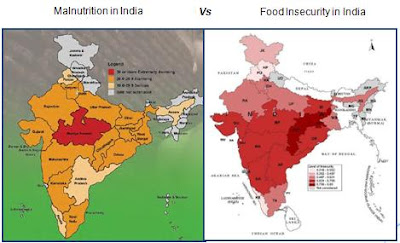Has Government lost the Food Security Plan for India?
Why Economic Survey & Budget 2017-18 silent on Food Security Plan and Implementable Agriculture Policy?
Has government lost the food security plan for India?
By:
Vijay Sardana
Food insecurity as a state in which “consistent access to adequate food is limited by a lack of money and other resources at times during the year.” Good shorthand terms for food insecurity are “struggling to avoid hunger,” “hungry, or at risk of hunger,” and “hungry, or faced by the threat of hunger.”
Every government claims that it is doing great job in the interest of country and people of India, irrespective
ideology and political affiliation, but the facts on ground are far from
satisfactory on most parameters which are concerned to common man when we
compare with other countries.
We have seen some good initiatives in
all sectors and radical steps like demonetization in last one year. Budget also
made lot of good announcements to please urban citizens after the shock of
demonetization and before GST, which will increase tax components of various
services and products consumed by urban citizens. They key challenge remains is
food inflation. In economic survey is silent about food security status of
India. This year’s economic survey does not even mention about the progress
made between last year and this year on various issues raised in last year’s
economic survey.
Ground reality about India’s food security:
To meet the demand of food for the
growing population, India will need at least 20 million tons of additional food
every year to meet the minimum nutritional requirements of the citizens. As of
today, we are way short of these targets and this is reflected in rising food
prices in the market place but not in distorted method of WPI and CPI
calculations. Today India is having acute shortage of edible oil, pulse, feed
materials and fodder and many other items. Per capita production is below what
is required as per nutritional recommendations.
This shortage is ranging from 30% to
60% of the actual requirement by the country. Food import bill has gone up by
Rs. 19,000 crores in last one year and food exports are down by Rs. 20,000
Crores in last one year. AT the same time food wastage is in the range of about
Rs. 80,000 crores. There is no mention of these hard facts in economic survey.
On the other hand, there is deliberate
policy attempt to curb the exports by fixing minimum export price and putting stock limits on essential
commodities to control the food prices for the urban consumers at the cost of
price realization by the farmers. At the same time government is not able
ensure minimum support price to the farmers which was promised in election
manifestos. The proposed MSP rates are much below than even Consumer Price
Inflation Index (CPI), forcing farmers to poverty. This clearly says that our
domestic supplies are not able to catch up with growing demand.
Rising prices of sugar, wheat, pulses,
vegetables, milk, honey, fruits, meat and egg are sending strong signals that
somewhere agriculture sector is not delivering as per plan.
According to Economic Survey 2015-16,
page 69 says, the central challenge of Indian agriculture is low productivity.
It evident in modest average yields. First, consider the main food grains –
wheat and rice. These two cereals are grown on the most fertile and irrigated
areas in the country. One caveat while comparing paddy yields is that varieties
are not exactly homogenous. Also the differences between varieties are large.
they use a large part of the resources that the government channels to
agriculture, whether water, fertiliser, power, credit or procurement under the
MSP program. Even then, average yields of wheat and rice in India are much
below that of China’s – 46 per cent below in the case of rice and 39 per cent
in the case of wheat. There is no mention in economic survey what was the
progress last year and budget is silent what is planned to address this
challenge because irrigation level in Punjab is already 99% of the cropping
area, fertilizer is available to them, then why productivity is going down? It
means our existing model of agriculture research and extension services has
failed to deliver as per the changing needs of society. We are still glorifying
the history of green revolution, but not realizing and accepting the fact that
other countries have performed better than us when it comes to agriculture
productivity. Still there is no attempt to reform these vital aspects of
agriculture.
What does this mean for Farm Incomes?
According to Economic Survey 201-16,
page 73, The negative consequences of low agriculture yields extend from
precarious incomes of farmers to large tracts of land locked in low value
agriculture, despite growing demands for high value products such as fruits,
vegetables, livestock products because of consumption diversification with
rising incomes and urbanisation. According to NSS data, the average annual
income of the median farmer net of production costs from cultivation is less
than INR 20,000 in 17
states, it means farmers get Rs. 54 per day, far below than minimum wages even in MGNREGA, is this achievement of the governments? It means, in money terms, farmers are worst than the unemployed people in this country in terms of annual income. This includes produce that farmers did not
sell (presumably used for self-consumption) valued at local market prices.
Given high wedges between retail and farm gate price, this might underestimate
income but it is still low. Moreover, the variance in agriculture income
between the more and less productive states is also very stark. There is no
mention in economic survey and in budget what government is thinking to address
this challenge. In the name of poverty there are many scheme to support but no
tangible attempt to increase farmers’ income.
According to Economic Survey 2015-16,
page 76, The absence of MSP procurement for most crops in most states implies
either that farmers are selling their products to private intermediaries above
the MSP or the converse, i.e., farmers have little option but to sell their
produce at prices below the MSP, to the monopolies and cartels created and
sponsored by government through APMC Act and supported by CACP illogical method
of MSP calculations, resulting in a regional bias in farm incomes and promoting
poverty.
There is a general sense that the
latter is a more prevalent phenomenon, highlighting the need for reorienting
agriculture price policies, such that MSPs are matched by public procurement
efforts towards crops that better reflect the country’s natural resource
scarcities. There is no mentioned of public procurement plan for crops other
than wheat and rice. Pulses was included in procurement agenda but failed to
ensure MSP for farmers in APMC market. There is no mentioned of oilseeds, where
we are importing our 60 to 70 percent of requirement. Oil cake is which are
vital to address the acute shortage for protein in animal diets for milk
production, livestock productivity and human health.
Government is projecting total
production for pulses in 2020-21 will be 24 million tons where according to WHO
recommendations, the demand will be about 40 million tons. Who will feed India pulses
and at what cost? Same is the case in Edible oil and other crops.
The best way for government to cover
its failure in addressing the growing gap between food & nutrition security
and food production is by refusing the actual nutritional requirements of
Indian population and livestock sector in order to cover the gap between demand
and production.
Allocation for in budget to address challenges mentioned
above:
Our total allocation for
Agriculture and Farmers’ welfare is Rs. 35,984 crore. Special focus has been
given to ensure adequate and timely flow of credit to the farmers. Against the
target of `8.5 lakh crore in 2015-16, the target for agricultural credit in
2016-17 will be an all-time high of Rs. 9 lakh crore and this year target is
about Rs. 10 lakh crores. To reduce the burden of loan repayment on farmers, a
provision of Rs.15,000 crore has been made in the BE 2016-17 towards interest
subvention and same is extended this year as well. Government has also approved
Prime Minister Fasal Bima Yojana and provided a sum of Rs. 5,500 crore in the
Budget 2016-17, extended the same this year.
With all this, has productivity
improved? Are farmers happy with the income they are getting? Are consumers
happy with the food prices in retail market? This is the moot question. Who is
benefitting from these schemes. Has poverty reduced with these schemes?
Where
are the results to address the food security?
According to the “Budget 2016-17’
speech of Finance Minister, we are grateful to our farmers for being the
backbone of the country’s food security. We need to think beyond ‘food
security’ and give back to our farmers a sense of ‘income security’. Government
will, therefore, reorient its interventions in the farm and non-farm sectors to
double the income of the farmers by 2022. There is no mentioned what are the
farmers’ income targets for 2019 before next general elections.
First of all, Government must
acknowledge that, the dependency on imports are going up, exports are going
down, yields are stagnant in most of the crops, cost of cultivation is going
up, farmers are not even getting the minimum support price for commodities
recommended by government and at the same time trade distorting policies like
stock limits, discouragement for exports like minimum export price which is
higher than world market prices are the rules of the game. These steps are to
keep the urban middle class, as consumers, happy at the cost of hardworking and
poor farmers. These policies are discouraging private investment away from
agriculture sectors.
There may be a surgical plan for
food security of India, but can we implement the same by keeping it secret from
the farmers, consumers and state governments in India, where agriculture is the
state subject?
As a citizen, I expect Economic
survey must highlight factual economic reality of India, not the dreams &
desires of authors of economic survey. I also expect serious debate on these
issues vital issues affecting common man and food security of India in the Parliament.



Comments
Post a Comment